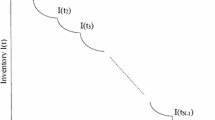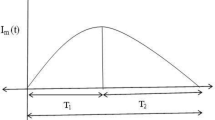Abstract
This paper considers a number of problems in a pharmaceutical downstream supply chain under specific constraints related to pharmaceutical products (e.g., their expiry date and regulations) and to inventory control (e.g., low prices of products, gift products or prices near zero, shortages prohibited but excess inventory allowed). As traditional models of inventory control and replenishment cannot optimize the total cost of the system, it is very important to consider the transportation cost as well. In this paper, we take into account some of these constraints and propose two models for multi-product replenishment policies, namely centralized and decentralized models. We seek to identify the best quantity and period of replenishment of products for a joint optimization of inventory and transportation costs. The proposed models can be applied to a specific family of products with a stable demand and high turnover rate, low prices (or gift products for some of them), and without any shortage. These two models are compared and the global approach is illustrated by a numerical example taken from a real-case study.
Similar content being viewed by others
References
Peidro D, Mula J, Poler R, Lario FC (2009) Quantitative models for supply chain planning under uncertainty: a review. Int J Adv Manuf Technol 43:400–420
Hill RM (1997) The single-vendor single-buyer integrated production-inventory model with a generalized policy. Eur J Oper Res 97:493–499
Goyal SK, Nebebe F (2000) Determination of economic production-shipment policy for a single-vendor-single-buyer system. Eur J Oper Res 121:175–178
Hoque MA, Goyal SK (2000) An optimal policy for a single-vendor single-buyer integrated production-inventory system with capacity constraint of the transport equipment. Int J Prod Econ 65:305–315
Ganeshan R (1999) Managing supply chain inventories: a multiple retailer, one warehouse, multiple supplier model. Int J Prod Econ 59:341–354
Swenseth SR, Godfrey MR (2002) Incorporating transportation costs into inventory replenishment decisions. Int J Prod Econ 77:113–130
Ertogral K, Darwish M, Ben-Daya M (2007) Production and shipment lot sizing in a vendor-buyer supply chain with transportation cost. Eur J Oper Res 176(3):1592–1606
Huang HC, Chew EP, Goh KH (2005) A two-echelon inventory system with transportation capacity constraint. Eur J Oper Res 167:129–143
Zhao QH, Wang SY, Lai KK, Xia GP (2004) Model and algorithm of an inventory problem with the consideration of transportation cost. Comput Ind Eng 46:389–397
Zhao Q, Chen S, Leung SCH, Lai KK (2010) Integration of inventory and transportation decisions in a logistics system. Transp Res E Logist Trans Rev 46(6):913–925
Qu WW, Bookbinder JH, Iyogun P (1999) An integrated inventory–transportation system with modified periodic policy for multiple products. Eur J Oper Res 115:254–269
Kutanoglu E, Lohiya D (2008) Integrated inventory and transportation mode selection: a service parts logistics system. Transp Res E Logist Trans Rev 44(5):665–683
Axsäter S (2003) Approximate optimization of a two-level distribution inventory system. Int J Prod Econ 81–82:545–553
Axsäter S (2005) A simple decision rule for decentralized two-echelon inventory control. Int J Prod Econ 93–94(8):53–59
Andersson J, Marklund J (2000) Decentralized inventory control in a two-level distribution system. Eur J Oper Res 127:483–506
Das C, Tyagi R (1997) Role of inventory and transportation costs in determining the optimal degree of centralization. Transp Res E Logist Trans Rev 33(3):171–179
Chen JM, Chen TH (2005) The multi-item replenishment problem in a two-echelon supply chain: the effect of centralization versus decentralization. Comput Oper Res 32:3191–3207
Abdul-Jalbar B, Gutiérrez J, Puerto J, Sicilia J (2003) Policies for inventory/distribution systems: the effect of centralization vs. decentralization. Int J Prod Econ 81-8(11):281–293
Kim CO, Jun J, Baek JK, Smith RL, Kim YD (2005) Adaptive inventory control models for supply chain management. Int J Adv Manuf Technol 26:1184–1192
Viswanathan S, Piplani R (2001) Coordinating supply chain inventories through common replenishment epochs. Eur J Oper Res 129:277–286
Mishra AK (2004) Selective discount for supplier-buyer coordination using common replenishment epochs. Eur J Oper Res 153:751–756
Li J, Liu L (2006) Supply chain coordination with quantity discount policy. Int J Prod Econ 101:89–98
Sayarshad HR, Tavakkoli-Moghaddam R (2010) Solving a multi periodic stochastic model of the rail–car fleet sizing by two-stage optimization formulation. Appl Math Model 34(5):1164–1174
Kang JH, Kim YD (2009) Inventory replenishment and delivery planning in a two-level supply chain with compound poisson demands. Int J Adv Manuf Technol 49(9–12):1107–1118
Pishvaee MS, Jolai F, Razmi J (2009) A stochastic optimization model for integrated forward/reverse logistics network design. J Manuf Syst 28(4):107–114
Pandey A, Masin M, Prabhu V (2007) Adaptive logistic controller for integrated design of distributed supply chains. J Manuf Syst 26(2):108–115
Baboli A, Pirayesh Neghab M, Haji R (2008) An algorithm for the determination of the economic order quantity in a two-level supply chain with transportation costs: comparison of decentralized with centralized decision. J Syst Sci Syst Eng 17(3):353–366
Shah N (2004) Pharmaceutical supply chains: key issues and strategies for optimisation. Comput Chem Eng 28(6–7):929–941
Hassan T, Baboli A, Guinet A (2006) Re-organizing the pharmaceutical supply chain downstream: implementation a new pharmacy. Symposium INCOM'2006. St-Etienne-France 3:727–732
Author information
Authors and Affiliations
Corresponding author
Rights and permissions
About this article
Cite this article
Baboli, A., Fondrevelle, J., Tavakkoli-Moghaddam, R. et al. A replenishment policy based on joint optimization in a downstream pharmaceutical supply chain: centralized vs. decentralized replenishment. Int J Adv Manuf Technol 57, 367–378 (2011). https://doi.org/10.1007/s00170-011-3290-x
Received:
Accepted:
Published:
Issue Date:
DOI: https://doi.org/10.1007/s00170-011-3290-x




